Menus
- The unfinished future
- Discovery
- In the saddle
- In the city
- On the road
- On the highway
- In duet
- Braking
- Consumption
- The interview
- Production
- Chronology
- Coast side
- Conclusion
The unfinished future
The brand with three tuning forks, wishing to prove its lead in terms of technology and innovation, unveiled its 1000 GTS at the Cologne Motor Show in 1992. A completely new original concept aimed at improving handling and braking. The front axle designed by James Parker is close to that of the Bimota Tesi presented two years earlier. The Omega chassis, a true work of art in an aluminum foundry, aims to connect the two swinging arms while conforming to the mechanics in order to reduce the bulk. This GT Sportive, with the formidable Genesis engine available at all speeds and torque, is equipped with electronic injection, a Lambda sensor and a catalytic exhaust and makes it the first so-called "clean" Japanese motorcycle ….

Discovery
By developing the revolutionary concept of the Omega frame, Yamaha’s goal was to build a new type of motorcycle as easy to use in everyday life as it is on long journeys…. At first glance, the appearance of the front axle and the Omega chassis suggest that this is a limousine reserved only for the great outdoors ….
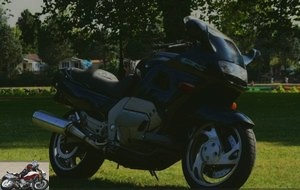
In the saddle
You can immediately see the size of the machine! The smallest maneuvers require constant grip and effort. On board, the position is correct, resting lightly on the wrists and you can feel a motorcycle rather well balanced with the center of gravity placed on the front. The seat is low, the controls ideally fall at the end of each limb.
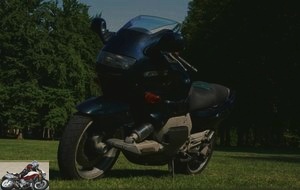
The dashboard is complete with its double odometer and digital clock located at the bottom of the dials, but unfortunately completely invisible since hidden by the half-handlebars ….
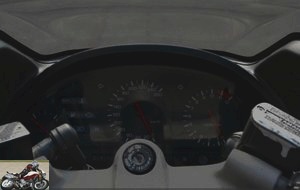
In the city
The first hectometers at low speed are confusing, the particular front axle generates strange reactions, fortunately quickly corrected instinctively. The feeling of heaviness is present, all the weight seems to be placed on the front. In fact, it is not, just an exercise of two or three street angles and a few zigzags is enough to get your hands on the 1000 GTS. Failing to be agile and ranked queen of the cities, she is doing well. However, instinctively, the rider of a 1000 GTS is used to following the bypass routes of metropolitan areas, the motorcycle is so uncomfortable there. !
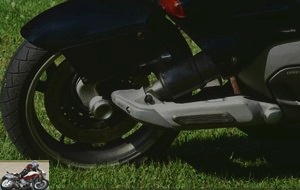
On the road
As soon as the GTS picks up speed, everything is back to normal, the feeling of heaviness in the front end is reassuring and the 130 tire seems to stick to the asphalt. The main roads allow you to appreciate the driving qualities of this mount. Surprisingly, the higher the speed, the more the masses are balanced and the more the wheels seem to be riveted to the road. The rigidity of the front single-arm system provides a breathtaking sense of security. Road holding is excellent. Although quite heavy to set on the corner, the GTS does not flinch and swallows even the fastest curves with perfect stability. The series of successive turns become a real pleasure, especially if they are interspersed with braking. On the other hand, on small bumpy roads the picture darkens seriously. The car-like front end goes into a panic and the bike stubbornly refuses to turn, waddling on its shocks. No doubt, the major axes and the motorway remain her pieces of choice where she remains unperturbed ….
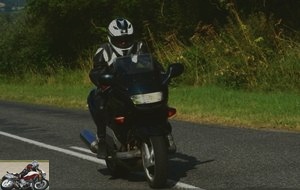
On the highway
With an attitude that has never been compromised, the 1000 GTS can be enjoyed on the motorway without restraint. The fairing protects well from turbulence, the engine craves more and the oiliness on board protects the pilot from fatigue. Certainly the favorite hunting ground of the Yamaha ….
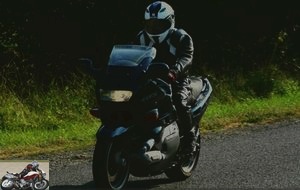
In duet
As a true traveler, the 1000 GTS is comfortable and very welcoming. Extremely well protected by the fairing and the screen (low or high, Yamaha provided both on delivery), pilot and passenger are pampered. In addition, the saddlebags (optional) have something to delight the transported ….
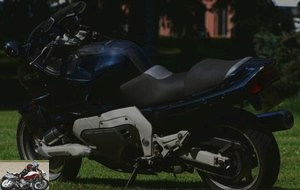
Braking
The powerful and enduring brakes are in line with road holding. Even under hard braking, the front dips slightly, the bike remains practically level and allows the single 320mm disc pinched by six pistons to fully express itself. The low pitch allows increased demand on the rear brake and thus allows excellent braking in complete safety, especially with the GTS-A version equipped with ABS ….

Consumption
The 1000cc Genesis, from the FZR, reworked and equipped with EFI injection is packed with torque. He shamelessly resumes all regimes with strength and vigor, without the slightest hesitation. Much to the chagrin of those nostalgic for carbs, only electronic fuel injection is capable of making an engine purr with perfect consistency, whatever the conditions. The EFI with the use of a Lambda probe coupled with a catalytic converter crowns the GTS with the coronation of the first so-called "clean" Japanese motorcycle. But cleanliness does not always rhyme with sobriety. Indeed, the "injected" 1000 is particularly greedy in sustained use and with a tank of only twenty liters the autonomy does not exceed 250 km ….
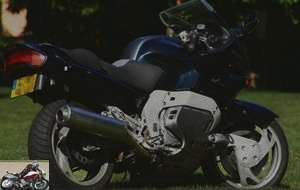
The interview
The GTS is a carefree motorcycle. Its engine, which has been proven on FZ, FZR and other FZXs, is known to be reliable. Routine maintenance and overhauls are greatly facilitated by electronic fuel injection. No more cleaning and synchronization of carburetors, tedious for novices (but regrettable for lovers of mercury)! This engine starts with a quarter-turn in all weather and in all situations. A close look at the hydraulic clutch slave cylinder is necessary around 60,000 km to prevent leakage of corrosive fluid. The cycle part ages quite well, except the plastic bodies which tend to tarnish. It’s good to see that cleaning and removing the front wheel is a snap thanks to the nose gear design. This bike would have deserved a cardan transmission to further simplify maintenance.
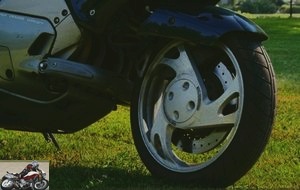
Production
Marketed in France in 1992 and withdrawn from the catalog in 1998, this bike has had a very bland career as the sales figures show. 10300 copies were produced, of which only 1299 found buyers in France, 603 GTS (without ABS) and 696 GTS-A (with ABS). Its positioning and the high price when it was released (€ 11,960 and up to € 12,580 with ABS), partly explain this failure.
Chronology
We distinguish the 1000 GTS by these four different colors: dark green, metallic blue, dark red and two-tone black / red in 1998.
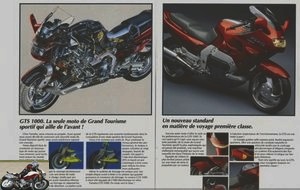
Coast side
Its price is on average around 2,500 €. € 2,000 for a high mileage model and € 3,500 for a machine in perfect condition. GTS are often found hitched to a basket because they are an excellent base for a sidecar. The Yamaha 1000 GTS is an ideal motorcycle for a collector (or future). Due to its originality, it may well increase in value over time..
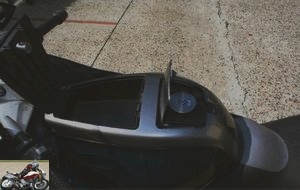
Conclusion
The GTS met with relative failure despite innovative and daring technology. The absence of a gimbal on such a Grand Touring machine largely contributed to this. Frankly a shame that the GTS is equipped with a transmission chain, the black point of the big wheeler. The wide 130 tire considerably weighs the front end at low speed. Yet this "unloved" will certainly take her revenge. Unique, visually stunning, discerning collectors are already on his trail !
Strong points
- Engine flexibility
- Excellent handling and heading
- Impeccable braking
- Aerodynamic protection
- "Clean" motorcycle
Weak points
- Low speed agility
- Reactions on bumpy roads
- Questionable aesthetics
- Autonomy / consumption
- Dashboard readability
The technical sheet of the Yamaha GTS 1000
Related articles
-
Birthday 4 cylinders in line, 1000 cm3, 202 hp, 117 Nm, 203 kg all full facts, 19,599 euros. Nice idea to resuscitate the R version of the GSX-R (the…
-
Trace strong and far The impressive commercial success of the Yamaha MTs is a quantified reality: 3,700 MT-09 (including 15% of Street Rallye and Sport…
-
Yamaha XT 660 R motorcycle test
City rat who knows how to transform into a field rat From the first letters, the XT informs that its history is loaded with lasting memories. Today XT…
-
Honda CBR 1000 RR Fireblade motorcycle test
20 years under the sign of total control 1992 saw the appearance of the very first CBR Fireblade, cubing 893 cm3 and has since become a sports icon. At…
-
New re-evolution High-end road symbol of the manufacturer with tuning forks, the FJR 1300 descends from a long line of dynamic travelers. The first of…
-
Samba Sambias ! What avid biker has never dreamed of owning and riding a Grand-Prix motorcycle approved for riding on the open road? The Sambiase…
-
Kawasaki Versys 1000 S Grand tourer motorcycle test
Daily test for fifteen days 1,043 cm3, 120 hp at 9,000 rpm, 102 Nm at 7,500 rpm, 257 kg, 15,099 euros (17,099 euros Grand Tourer version) This bike, to…
-
Yamaha RZV 500R motorcycle test
GP 500 2 stroke … road ! 50 ° V4, 494 cc, 100 hp, 134 kg Sports bikers are familiar with the Yamaha RD 500 LC, inspired by Kenny Roberts’ YZR500….
-
200 hp at 13,500 rpm, 112 N.m at 11,500 rpm, 199 kilos with full fuel, from € 18,499 Is the Crossplane engine an advantage in road use ? Even if the…
-
V-Max without mask Barely out and already cult! However, it is as heavy as an anvil, imposes trajectories worthy of a gondola and its autonomy does not…
The young boss of Royal Enfield won the award for the best Indian entrepreneur for the year 2015. He restructured Eicher, a mediocre family empire (he says) of about fifteen companies and reduced it to 3 companies including Volvo (trucks) and Polaris (4×4 agricultural generator car) in their pool and Royal Enfield for motorcycles, with a marked ambition for export.
The Royal Enfield segment is the bobo (left-handed bourgeois) of the middle class, between 30 and 40 years old, preferably living in a western urban environment (according to the company). The Royal Enfield is not recommended for a beginner: it is a heavy motorcycle, which vibrates a lot and needs constant care. And that is expensive, by design, the manager imposed it on dealerships, which cannot lower their prices, this applies to motorcycles but includes merchandising, t-shirts, accessories, etc. This is the price to pay to enter the "Enfield tribe".
We are in the midst of niche marketing (targeted capitalism). Royal Enfield copies the US sales methods used by com agencies. of the Harley brand: networks of unique distributors, typed motorcycles, redesigned logos, belonging to a clan, to a history, theme tours, concentrations, parties, alcohol, girls. The Royal Enfield has never been Indian, it is an ancient colonial symbol that we will Indianize, mythologize. We don’t ride a motorbike, we travel in an Enfield, we ride a bullet. When it was launched in Delhi in 2016, the Royal Enfield Himalayan was presented as the motorcycle that hugs the mountains (myth of Shiva having married Parvati, the daughter of Lord Himavan, king of the Himalayas in the Hindu religion).
If factories are growing and production is soaring it is because the cost of labor is falling in India, land is easily acquired and tax gifts are generously granted. There have been strikes in the factories but the workers are reluctant to protest. We can understand them, because it is the army which shoots on sight to stop their movements considered illegal. Rest assured about their health, they will soon be replaced by robots. India is democratizing.
Siddharta Lal knows he has taken the lead, somewhat illegitimately [poorly prepared motorcycle] and illegally [not up to anti-pollution standards] in the tourer and 400cc segment. He knows that the obligation of injection and ABS will seal him off on Indian soil. The Royal Enfield company is a small player despite its impressive leap forward (from 50,000 units to 450,000 in 10 years). The big player is the Indian giant Bajaj, cars, trucks, motorcycles, scooters, (the production of just one of its models represents more than all the Royal Enfields put together) It has just released the Dominar 400, announced in 2012, it comes graze on the lands of RE Dominar, its name shows its intention to impose itself on the 400cc tourer segment, a nightmare for RE The dominar is a racy beast, with injection, ABS, powered by the fiery 390cc of KTM and for a price (1,800 euros in India) ten times below the RE Hymalayan injection ABS (11,200 euros in England).
There are other Indian players who overshadow the 410cc touring from Royal Enfield, such as Mahindra’s Mojo 300cc, 2400 euros, or the Akula RTR 300 from TVS (BMW 310cc engine). But it is above all the foreign competition that scares Royal Enfield. Like the young little BMW G310R, 300cc at 3500 euros, faster than all the Enfields. Or the KTM tourer 390cc which will arrive soon. The Indians have always preferred, when prices held up, the solid proven foreign to the unreliable and old-fashioned domestic production..
By choosing to type its motorcycles, to create a new model and segment, Royal Enfield is creating an image of renovator in continuity but remains in a niche market quite expensive for export. The company should be able to withstand economic shocks thanks to its restructuring (70 million euros in 2015, profits: 48 million) and to the support of the family group Eicher motors limited (460 million euros in profits in 2012). "My ambition is to make Royal Enfield an international brand" Siddhartha Lal Managing Director of Royal Enfield. The R.E. 750cc that we are all waiting for will confirm it. Or will Mr. Lal have to push the plug even further by making 1000cc Vtwins that will compete with the magnificent preparations of the 1000cc Australian Carberry Enfields now assembled in eastern India ?
More and more political, wage and social protests affect India. Growth is only 6% (not even in our dreams) but it only affects Indian multinationals and their areas and corridors of economic modernization. India is being torn up by its own Americanized children, with globalized finances. All this hardly bodes well for a bright and lasting future.
thank you
The Royal Enfield Himalayan injection ABS would be (it’s so amazing) priced at 11,500 euros in England. What is certain commercial suicide.
The Indian owners of Royal Enfield are reselling their Classic 500 to buy the Bajaj Dominar 400 (2 out of 10 buyers were driving an Enfield), The Dominar 400 is a comfortable, lighter, more modern and faster tourer than "the classic" Himalayan.
Competition is exploding due to joint ventures and direct imports from foreign brands. The fight promises to be tough for Eicher Motors, which owns Royal Enfield. They could put their priority back on the production of cars and utility vehicles. Royal Enfield became an export brand, sold in India as an international brand for hipsters..
Young Indians go elsewhere, the motorcycle market too.
RE is perfect for starting in A2! I know what I mean ! I have one ! My first motorbike! In order not to die an idiot, I went to the dealerships to try out the motorcycles that I like and that are eligible for A2. Well I realize what the RE now represents for me, beyond the first bike and its nice style, it is above all a very marked identity with an engine that lives with real noise and good vibrations! So yes it affects in the turns, it tops out at 110km.h … But we get used to it, we adapt our driving and we stay on the nationals, and it’s his playground !
Otherwise just to bounce back from the previous comment (I had a hard time with the end-of-counter analyzes) Polaris, which also includes Indian and the late Victory, does not belong to Eicher in any way, but Ducati soon! 😉
Between Royal Enfield and Garage Heritage in the Val de Marne, it’s a very long story! Auto Moto has concocted a very nice article for us! [www.auto-moto.com]